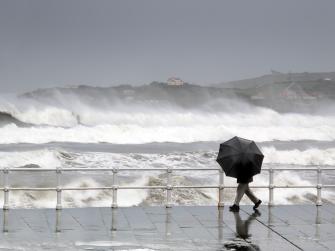Extreme weather is getting a boost from
climate change
climate change
Scientists are detecting a stronger link between the planet’s warming and its changing weather patterns.
And the trajectory is clear — hotter heat waves, drier droughts and stronger storms.

Hurricanes and floods
A warming Earth creates conditions that fuel dangerous hurricanes and floods.
For example, higher temperatures boost evaporation, which leads to more moisture in the atmosphere. This can cause rainfall to intensify. And rising sea levels can lead to higher storm surges and more floods.
Two phenomena tied to global warming are driving sea level rise: Melting glaciers and ice sheets, and the expansion of warming oceans. (Water generally expands as it heats up.)
In addition to devastating downpours and storm surges, the latest research suggests that we’ll see stronger hurricanes as the planet heats up.
And hurricanes are getting stronger faster. When that happens close to landfall, people have less time to gather loved ones, secure their homes and move to safety.
How climate change makes hurricanes more destructive
Heat and drought
The dangerous effects of heat waves, including death, occur as a result of both temperature and humidity — especially if those conditions persist for more than two days.
With temperature records being smashed year after year, human-caused global warming is making extreme heat events more frequent.
And as warmer temperatures increase evaporation, it dries out the soil — intensifying drought over many areas.
Extreme heat calls for extreme action
Wildfires
Wildfires are closely connected to the weather. Climate change makes wildfires worse by stoking the hot, dry conditions that fuel these fires.
When it’s warmer, more moisture evaporates from soil and vegetation, drying out trees, shrubs and grass and turning fallen leaves and branches into kindling. Drought and earlier snowmelts can also make landscapes more likely to burn.
Climate change isn’t the only factor influencing wildfire threats. How we take care of our forests matters greatly, too. So do decisions about how we use the land, such as where we build houses and other infrastructure.
But the risk of extreme wildfires is expected to rise in a warming world, with serious consequences. Catastrophic wildfires devastate communities and ecosystems, and produce smoke that can travel far, making air quality worse thousands of miles away.
What does a hotter planet mean for wildfires?
Snow
If the Earth is warming, why are we still seeing so much snow?
The answer: It’s complicated.
Many places are getting less snow. But remember — there is more moisture in a warmer atmosphere. So when temperatures are below freezing, that moisture can fall as snow, fueling heavy snowstorms.










